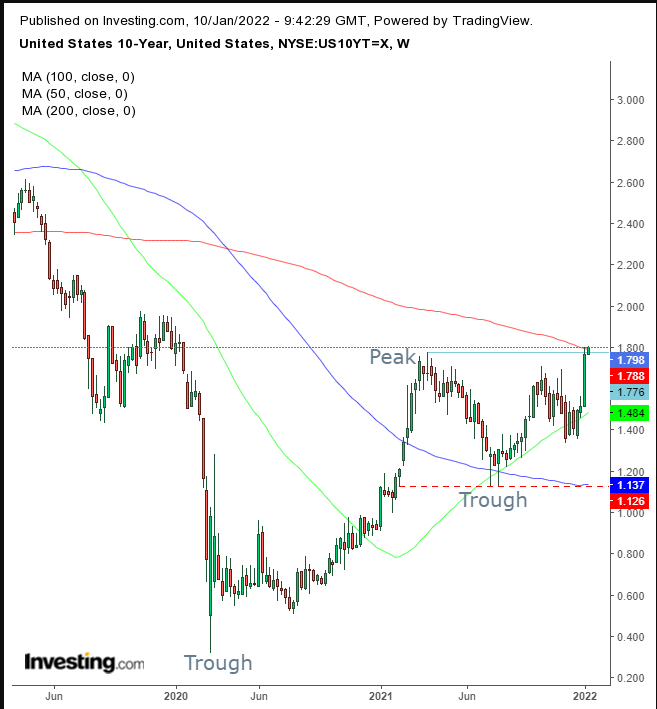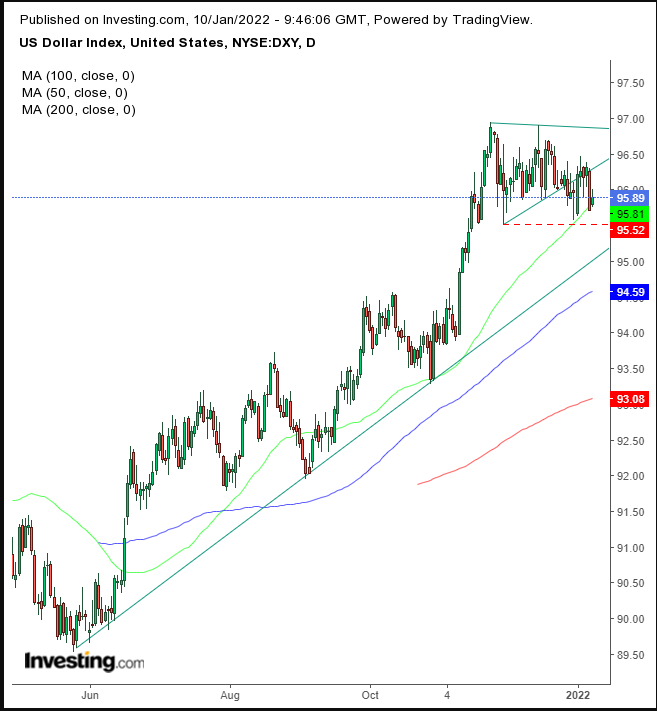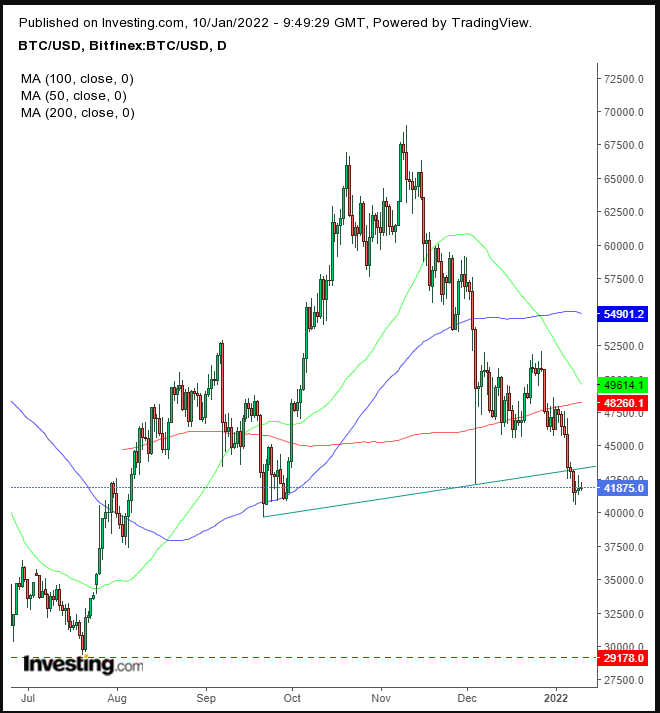- Markets eye US CPI and earnings season
- Treasury yields touch 1.8%
- Bitcoin under pressure
Key Events
After a mixed Asian session on Monday, US futures on the Dow Jones, S&P 500 NASDAQ and Russell 2000 oscillated between gains and losses amid a European selloff as traders await key US CPI figures on Wednesday as well as the start of earnings season later this week.
The Treasury selloff resumed.
Global Financial Affairs
US futures were mixed and volatile as investors await indications on the state of the country's economy from major players in the financial sector which are due to kick-off the Q4 2021 earnings season on Friday when global lenders JPMorgan Chase (NYSE:JPM), Citigroup (NYSE:C) and Wells Fargo (NYSE:WFC) report.
Contracts on the Russell 2000 earlier underperformed, though that has since reversed, with NASDAQ futures now lagging at time of publication. It would appear the market narrative continues to flip-flop between jitters about the ongoing pandemic escalation and anticipation of an opening economy.
In Europe, the STOXX 600 Index, which initially opened 0.27% higher, fell 0.64% into negative territory and at the time of writing was 0.43% lower. The ups and downs in the regional benchmark revealed the themes motivating traders there. The financial services sector rallied as it is expected to benefit from higher interest rates. Energy firms tracked the oil price and also moved higher. Clearly, there's a case for the cyclical trade as economic-sensitive sectors are outperforming.
We have also seen that value stocks often outperform, even amid a market narrative of continued restrictions. However, it appears that European traders see no such risk as a lockdown favorite, the technology sector, declined. Perhaps the biggest indicator that European traders' concerns on Omicron are receding is that Travel & Leisure stocks rallied after a report that the ratio of hospitalizations and deaths versus overall cases in South Africa was much smaller for Omicron than for the Delta variant.
The Asian trading week opened lower, as traders tracked Friday's selloff on Wall Street after the Fed minutes revealed the central bank could begin raising interest rates as soon as March. As we have often pointed out, investors focused on the negative outlook regarding tightening monetary policy while ignoring the Fed's positive message that the US job market is healthy and can endure higher interest rates. That assessment was reinforced by Friday's employment figures which demonstrated better-than-expected wage figures even if job creation was only half of forecasts.
Hong Kong's Hang Seng added 1.08%, outperforming South Korea's KOSPI which declined 0.95%, lagging among regional peers. Japanese markets were closed for a holiday.
Treasury yields on the 10-year note extended a climb for a seventh straight day, touching 1.8% at one point. However they slipped back to 1.794% which is the highest since Jan. 20, 2010, erasing the virus-related decline. The current bond selloff is due to the expectation of higher interest rates.

Yields have completed a peak-and-trough uptrend, though rates are now contending with the 200 DMA. If they continue higher, the 50 DMA will take on the 200 DMA for a Golden Cross.
The dollar opened higher but found resistance, pushing the greenback below session highs.

The USD may have blown out an Ascending Triangle, a bearish development. However, the global reserve currency could also be trading within a neutral Rectangle pattern. We have been waiting for a resolution for the sideways move since the Nov. 24 record, which we hope to see till the price meets with its uptrend line since the late-May low.
Gold edged lower as traders await inflation updates.

The yellow metal is still lost within its neutral, triangular range.
Bitcoin traded below an H&S top for the fourth day, increasing the odds of follow-through as the 50 DMA dives toward the 200 DMA, threatening a Death Cross.

In that scenario, the cryptocurrency could return to its lowest levels. On the other hand, there may be 3 fundamental reasons Bitcoin and its crypto 'cousin' Ethereum could rally sooner rather than later.
Oil recovered from a second-day slide as outputs recovered while others shut down in some spots.

From a technical perspective, bulls may find it challenging to keep pushing prices higher within the trading pattern since the early-December low, as prices may have become overbought within a rising channel, indeed some may even consider it a rising wedge.
Up Ahead
- Fed Chair Jerome Powell's confirmation hearing takes place in the Senate Banking Committee on Tuesday.
- On Wednesday crude oil inventories are published.
- Earnings season starts on Friday with results from JPMorgan Chase.
Market Moves
Stocks
- The STOXX 600 was little changed
- Futures on the S&P 500 rose 0.1%
- Futures on the NASDAQ 100 were little changed
- Futures on the Dow Jones Industrial Average rose 0.1%
- The MSCI Asia Pacific Index rose 0.4%
- The MSCI Emerging Markets Index rose 0.7%
Currencies
- The Dollar Index was little changed
- The euro fell 0.2% to $1.1335
- The Japanese yen was little changed at 115.66 per dollar
- The offshore yuan was little changed at 6.3814 per dollar
- The British pound was little changed at $1.3598
Bonds
- The yield on 10-year Treasuries advanced three basis points to 1.79%
- Germany's 10-year yield rose one basis point to -0.03%
- Britain's 10-year yield increased two basis points to 1.20%
Commodities
- WTI crude was up 0.44% at $79.27 a barrel
- Brent crude rose 0.43% to $82.10 a barrel
- Spot gold was little changed
